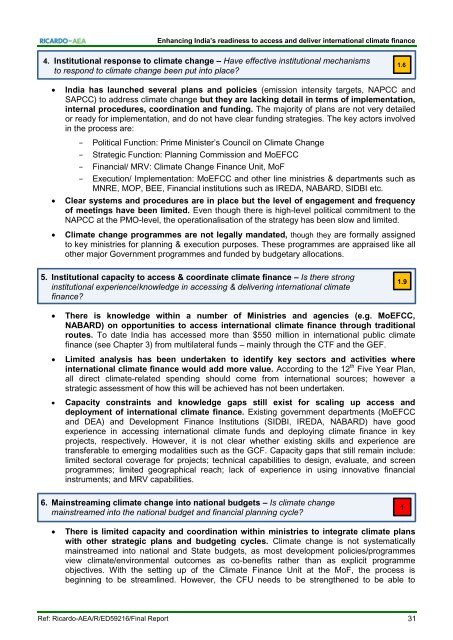Enhancing India’s Readiness to Climate Finance
India has taken several steps to improve its national response to climate change. India’s climate finance requirements, however, are very high, and will need to be met through a combination of public, private and international climate finance. See more at: http://shaktifoundation.in/
India has taken several steps to improve its national response to climate change. India’s climate finance requirements, however, are very high, and will need to be met through a combination of public, private and international climate finance. See more at: http://shaktifoundation.in/
- No tags were found...
Create successful ePaper yourself
Turn your PDF publications into a flip-book with our unique Google optimized e-Paper software.
<strong>Enhancing</strong> <strong>India’s</strong> readiness <strong>to</strong> access and deliver international climate finance<br />
4. Institutional response <strong>to</strong> climate change – Have effective institutional mechanisms<br />
<strong>to</strong> respond <strong>to</strong> climate change been put in<strong>to</strong> place?<br />
1.6<br />
<br />
<br />
<br />
India has launched several plans and policies (emission intensity targets, NAPCC and<br />
SAPCC) <strong>to</strong> address climate change but they are lacking detail in terms of implementation,<br />
internal procedures, coordination and funding. The majority of plans are not very detailed<br />
or ready for implementation, and do not have clear funding strategies. The key ac<strong>to</strong>rs involved<br />
in the process are:<br />
−<br />
−<br />
−<br />
−<br />
Political Function: Prime Minister’s Council on <strong>Climate</strong> Change<br />
Strategic Function: Planning Commission and MoEFCC<br />
Financial/ MRV: <strong>Climate</strong> Change <strong>Finance</strong> Unit, MoF<br />
Execution/ Implementation: MoEFCC and other line ministries & departments such as<br />
MNRE, MOP, BEE, Financial institutions such as IREDA, NABARD, SIDBI etc.<br />
Clear systems and procedures are in place but the level of engagement and frequency<br />
of meetings have been limited. Even though there is high-level political commitment <strong>to</strong> the<br />
NAPCC at the PMO-level, the operationalisation of the strategy has been slow and limited.<br />
<strong>Climate</strong> change programmes are not legally mandated, though they are formally assigned<br />
<strong>to</strong> key ministries for planning & execution purposes. These programmes are appraised like all<br />
other major Government programmes and funded by budgetary allocations.<br />
5. Institutional capacity <strong>to</strong> access & coordinate climate finance – Is there strong<br />
institutional experience/knowledge in accessing & delivering international climate<br />
finance?<br />
1.9<br />
<br />
<br />
<br />
There is knowledge within a number of Ministries and agencies (e.g. MoEFCC,<br />
NABARD) on opportunities <strong>to</strong> access international climate finance through traditional<br />
routes. To date India has accessed more than $550 million in international public climate<br />
finance (see Chapter 3) from multilateral funds – mainly through the CTF and the GEF.<br />
Limited analysis has been undertaken <strong>to</strong> identify key sec<strong>to</strong>rs and activities where<br />
international climate finance would add more value. According <strong>to</strong> the 12 th Five Year Plan,<br />
all direct climate-related spending should come from international sources; however a<br />
strategic assessment of how this will be achieved has not been undertaken.<br />
Capacity constraints and knowledge gaps still exist for scaling up access and<br />
deployment of international climate finance. Existing government departments (MoEFCC<br />
and DEA) and Development <strong>Finance</strong> Institutions (SIDBI, IREDA, NABARD) have good<br />
experience in accessing international climate funds and deploying climate finance in key<br />
projects, respectively. However, it is not clear whether existing skills and experience are<br />
transferable <strong>to</strong> emerging modalities such as the GCF. Capacity gaps that still remain include:<br />
limited sec<strong>to</strong>ral coverage for projects; technical capabilities <strong>to</strong> design, evaluate, and screen<br />
programmes; limited geographical reach; lack of experience in using innovative financial<br />
instruments; and MRV capabilities.<br />
6. Mainstreaming climate change in<strong>to</strong> national budgets – Is climate change<br />
mainstreamed in<strong>to</strong> the national budget and financial planning cycle?<br />
1<br />
<br />
There is limited capacity and coordination within ministries <strong>to</strong> integrate climate plans<br />
with other strategic plans and budgeting cycles. <strong>Climate</strong> change is not systematically<br />
mainstreamed in<strong>to</strong> national and State budgets, as most development policies/programmes<br />
view climate/environmental outcomes as co-benefits rather than as explicit programme<br />
objectives. With the setting up of the <strong>Climate</strong> <strong>Finance</strong> Unit at the MoF, the process is<br />
beginning <strong>to</strong> be streamlined. However, the CFU needs <strong>to</strong> be strengthened <strong>to</strong> be able <strong>to</strong><br />
Ref: Ricardo-AEA/R/ED59216/Final Report<br />
31

















